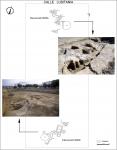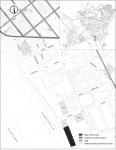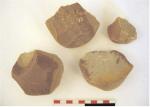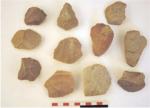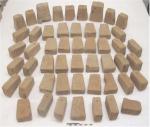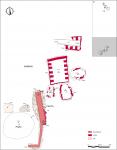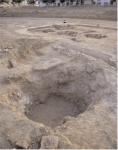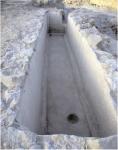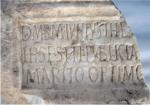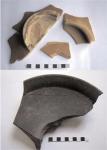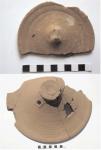Summary (English)
The site is located outside the walls of the Roman town, at a distance of around 500 meters from the walls and very close to the river Guadiana. The location of the site in this protected area required cores to be carried out by the Seguimiento de Obras team. Based on the positive results from the cores, an excavation area of 15 by 10 meters was carried out, while the slopes of the rest of the site were being monitored with mechanical tools.
In this way the establishments of a potter´s workshop were documented and, thanks to the control over earth miovement, a cremation grave was found as well as a furnace and a well. Until the Roman ruins and their associated transit levels, there were about 90 centimeters of deposits with a very simple stratigraphy formed by a superficial topsoil level of 18 cm in thickness without stones and of a dark brownish-gray color. Above the ground level closest to the furnaces deposits of Paleolithic carved pebbles were found. It should be pointed out that this lithic industry does not appear to be grouped nor to be marking a surface; although its quantity is significant, it is not located in a gravel bed of which “potential artifacts” have been selected; the material is in a setting without stones where, if occasionally, a rolling stone appears, it is of great size or it is a chipping stone. Despite the danger of giving a specific chronological record for this lithic material, we have chosen to classify it, given its general characteristics for the preparation of the core, production of support with predetermined morphology and the reduction of the size and weight of the pieces, within the Modo 3 or the Middle Paleolithic.
In short, in this sector of Merida we have two potter´s workshops established in the 1st century whose activity ended at an uncertain point in time during the second century. In the course of its active life, five furnaces were built in each of the potteries and in the surroundings a muddy ground was excavated which was turned into a landfill site with the same dating. Between both industrial sites there is a grave that cannot be contemporary to the potteries, but appears to point indirectly to the disappearance of the workshops.
Inside the well of the first potter´s workshop a Roman funeral epigraph was found, dated to the second century AD and dedicated by Publicia to her ideal husband. This well could have continued being of use for agriculture and livestock long after the disappearance of the pottery. On the other hand, the funeral area of the intervention is dated to the 3rd century. It is clear that the end of the industrial activity was not due to the pressure of the funeral area; otherwise tombs would have ended up occupying these areas, but this never came to occur except for this isolated grave.
After the excavation all of the Roman structures were filled with sand upon which a layer of topsoil from the excavation was put to provide the base for a cement slab. The height of the new building was revised to coincide with the nature of the cement slab. The highest area, corresponding to the first set of kilns, was also protected by a cement slab and the height differences were solved by using this space to set up storerooms.
(translation by Esther Casares Carmona)
- Miguel Alba Calzado
Director
- Miguel Alba Calzado (Consorcio Ciudad Monumental de Mérida)
Team
- Miguel Alba
- José Jiménez
- Javier Pacheco
- Mauricio Conde y Aniceto Palencia (empresa constructora)
Research Body
- Consorcio Ciudad Monumental de Mérida
Funding Body
- Nova Romana S.L.





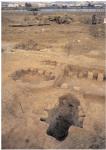
![Download [PDF]](/excavation/skins/fasti/images/results/download_sml.png)
